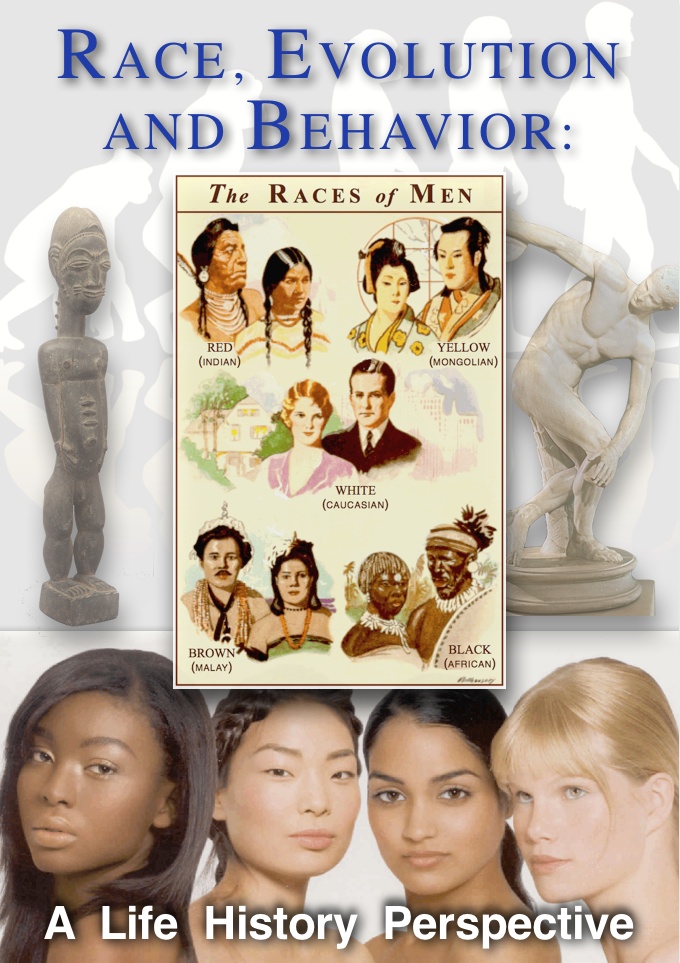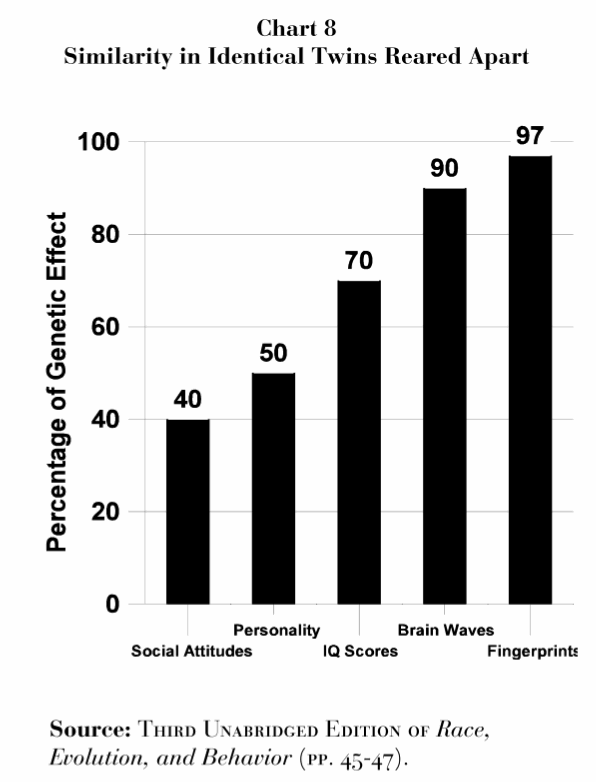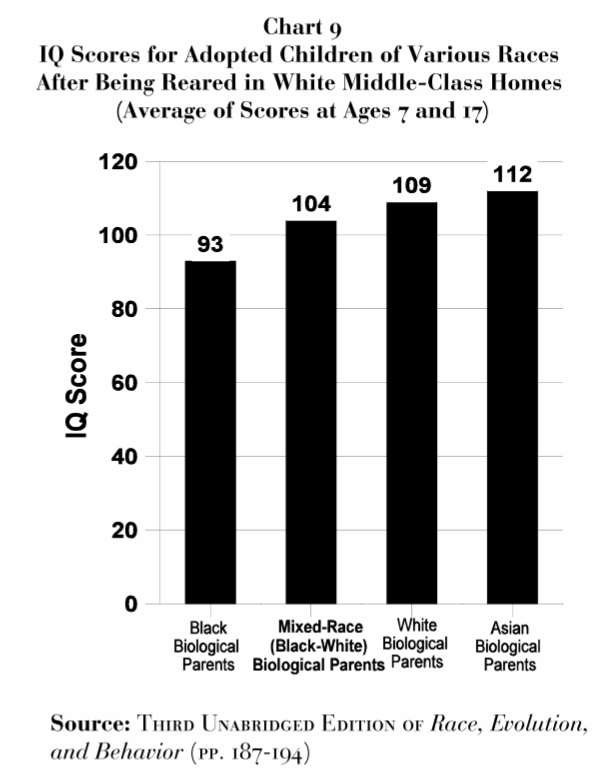RACE, EVOLUTION, AND BEHAVIOR:
A Life History Perspective
[Part 5]
2nd Special Abridged Edition
By Professor J. Philippe Rushton
University of Western Ontario
London, Ontario, Canada N6A 5C2
Author
J. Philippe Rushton is a professor of psychology at the University of Western Ontario, London, Ontario, Canada. Rushton holds two doctorates from the University of London (Ph.D. and D.Sc) and is a Fellow of the John Simon Guggenheim Foundation, the American Association for the Advancement of Science, and the American, British, and Canadian Psychological Associations. He is also a member of the Behavior Genetics Association, the Human Behavior and Evolution Society, and the Society for Neuroscience. Rushton has published six books and nearly 200 articles. In 1992 the Institute for Scientific Information ranked him the 22nd most published psychologist and the 11th most cited. Professor Rushton is listed in Who’s Who in Science and Technology, Who’s Who in International Authors, and Who’s Who in Canada.
[Page 5]
Contents
Preface 6
1. Race is More Than Skin Deep 7
Race in History
Race in Today’s World
Why Are There Race Differences?
Conclusion
Additional Readings
2. Maturation, Crime, and Parenting 13
Maturation
Crime
Personality, Aggression, and Self-Esteem
Parenting and Out-of-Wedlock Births
Longevity and Population Growth
Conclusion
Additional Readings
3. Sex, Hormones, and AIDS 18
Sexual Behavior and Attitudes
Sexual Physiology and Anatomy
AIDS and HIV
Conclusion
Additional Readings
4. Intelligence and Brain Size 22
Culture Fair Tests
Intelligence and Brain Size
Race Differences in Brain Size
Magnetic Resonance Imaging
Brain Weight at Autopsy
Measuring Skull Size
Measuring Living Heads
Summarizing Brain Size Differences
Conclusion
Additional Readings
5. Genes, Environment, or Both? 28
Heritability Studies
Adoption Studies
Race and Heritability
Trans-racial Adoption Studies
Heritabilities Predict Racial Differences
Regression to the Average
Conclusion
Additional Readings
6. Life History Theory 34
r-K Life History Theory
Race Differences and r-K Strategies
Testosterone — The Master Switch?
Conclusion
Additional Readings
7. Out of Africa 39
The Evidence
Geography and Race
Conclusion
Additional Readings
8. Questions and Answers 42
Is Race a Useful Concept? (Chapter 1)
Are the Race Differences Real? (Chapters 2 through 5)
Is the Relationship Between Race and Crime Valid? (Chapter 2)
Is the Relationship Between Race and Reproduction Valid? (Chapter 3)
Is the Genetic Evidence Flawed? (Chapter 5)
Is r-K Theory Correct? (Chapter 6)
Aren’t Environmental Explanations Sufficient? (Chapter 5)
Is Race Science Immoral? (Chapter 1)
Closing Thoughts
Additional Readings
[Page 6]
[Page 28]
5: Genes, Environment and Brain Size
A number of studies show that race differences are caused by both genes and environment. Heritabilities, cross-race adoptions, genetic weights, and regression-to- the-average all tell the same story. Cross-race adoptions give some of the best proof that the genes cause race differences in IQ. Growing up in a middle-class White home does not lower the average IQ for Orientals nor raise it for Blacks.
Can any environmental factor explain all the data on speed of dental development, age of sexual maturity, brain size, IQ, testosterone level, and the number of multiple births? Genes seem to be involved. But how can we know for sure?
Some traits are clearly inherited. For example, we know that the race differences in twinning rate are due to heredity and not to the environment. Studies of Oriental, White, and Mixed-Race children in Hawaii and of White, Black, and Mixed-Race children in Brazil show that it is the mother’s race, and not the father’s, that is the determining factor. But the role of racial heredity is found for other traits as well.
Heritability Studies
Heritability is the amount of variation in a trait due to the genes. A heritability of 1.00 means that the differences are inborn and the environment has no effect. A heritability of zero (0.00) means the trait is controlled by the environment and not at all by the genes. A heritability of 0.50 means that the differences come from both the genes and the environment.
Heritability is useful for animal breeders. They like to know how much genes influence things like milk yields and beefiness in cattle or determine which dogs can hunt, and which are good with children. The higher the heritability, the more the offspring will resemble their parents. On the other hand, low heritabilities mean that environmental factors like diet and health are more important.
For people, we measure heritability by comparing family members, especially identical with fraternal twins, and adopted children with ordinary brothers and sisters. Identical twins share 100% of their genes, while fraternal twins share only 50%. Ordinary brothers and sisters also share 50% of their genes, while adopted children share no genes. If genes are important, identical twins should be twice as similar to each other as are fraternal twins or ordinary siblings — and so they are.
Some identical twins are separated early in life and grow up apart. The famous Minnesota Twin Study by Thomas J. Bouchard and others compared many of these. (See Chart 8).
Even though they grew up in different homes, identical twins grow to be very similar to each other. They are similar both in physical traits (like height and fingerprints) and in behavioral traits (like IQ and personality). Identical twins who grow up in different homes share all their genes but do not share the effects of upbringing. As you can see in Chart 8, heredity accounted for 97% of the difference for fingerprints, and the environment only 3%. Social attitudes were 40% heredity, 60% environment. IQ was 70% heredity, 30% environment.
Identical twins are often so alike that even close friends cannot tell them apart. Although the twins in the Minnesota Project lived separate lives, they shared many likes and dislikes. They often had the same hobbies and enjoyed the same music, food, and clothes. Their manners and gestures were often the same. The twins were very alike in when they got married (and sometimes divorced) and in the jobs they held. They even gave similar names to their children and pets.
[Page 29]
One of these pairs, the “Jim twins,” were adopted as infants by two different working-class families. But they marked their lives with a trail of similar names. Both named their childhood pet “Toy”. Both married and divorced women named Linda and then married women named Betty. One twin named his son James Allen, the other named his son James Alan.
Another pair of separated twins were helpless gigglers. Each twin said her adoptive parents were reserved and serious. Each one said she never met anyone who laughed as easily as she did — until she met her twin!
Heredity also affects the sex drive. The age of our first sexual experience, how often we have sex, and our total number of sexual partners all have heritabilities of about 50%. So do the odds that we will get divorced. Several studies find that homosexuality, lesbianism, and other sexual orientations are about 50% genetic.
Twin studies show that even social attitudes are partly genetic in origin. One Australian study of 4,000 twin pairs found there was a genetic influence on specific political beliefs like capital punishment, abortion, and immigration. It turns out that criminal tendency is also heritable. About 50% of identical twins with criminal records have twins with criminal records, while only about 25% of fraternal twins do.
Genes influence helping behavior and aggression. A large study of British twins found that the desire to help or hurt others has a heritability of around 50%. For men, fighting, carrying a weapon, and struggling with a police officer are all about 50% heritable.
[Page 30]
My article in the 1989 Behavioral and Brain Sciences shows that who we marry and who we choose as friends is also partly genetic. When the blood groups and heritabilities of friends and spouses are compared, we find that people chose partners who are genetically similar to themselves. The tendency for like to attract like is rooted in the genes.
Adoption Studies
A good check on the results of twin studies comes from adoption studies. A Danish study (in the 1984 issue of Science) examined 14,427 children separated from their birth parents as infants. Boys were more likely to have a criminal record if their birth parents had a criminal record than if their adoptive parents did. Even though they were brought up in different homes, 20% of the full brothers and 13% of the half-brothers had similar criminal records. Only 9% of the unrelated boys brought up in the same home both had criminal records.
The Colorado Adoption Project found that genes increase in influence as we age. Between age 3 and 16, adopted children grew to be more like their birth parents in height, weight, and IQ. By age 16 the adopted children did not resemble the people who had reared them. The heritability of height, weight, and IQ in infancy are all about 30%. By the teenage years, they are about 50%, and by adulthood, they are about 80%. Thus, as children grow older, their home environments have less impact and their genes have more impact, just the opposite of what culture theory predicts.
Race and Heritability
Can heritability tell us anything about the differences between races? Yes, a lot! Studies show that when the heritability is high in Whites, it is also high in Orientals and Blacks. When it is low in Whites, it is also low in Orientals and Blacks. For example, the heritability of IQ is about 50% for Blacks, Orientals, and other groups, just as it is for Whites. So there is a genetic basis for intelligence in all three races.
One study used the Armed Services Vocational Aptitude Battery (ASVAB), given to many men and women going into the military. It found that in all three races the similarity among siblings was the same. The genetic influence on IQ in Orientals, Whites, and Blacks is about equal. There is no special factor, like the history of slavery or White racism, that has made cultural influences stronger for one race than for another.
Trans-racial Adoption Studies
The best evidence for the genetic basis of race-IQ differences comes from trans-racial adoption studies of Oriental children, Black children, and Mixed-Race children. All these children have been adopted by White parents at an early age and have grown up in middle-class White homes.
One well known trans-racial adoption study is Sandra Scarr’s Minnesota project. The adopted children were either White, Black, or Mixed-Race (Black-White) babies. The children took IQ tests when they were seven years old and again when they were 17.
In their initial report, the authors thought that their study proved that a good home could raise the IQs of Black children. At age 7, their IQ was 97, well above the Black average of 85 and almost equal to the White average of 100. However, when the children were retested at age 17, the results told another story (reported in the 1992 issue of Intelligence).
At age seven, Black, Mixed-Race, and White adopted children all had higher IQ scores than average for their group. Growing up in a good home helped all the children. Even so, the racial pattern was exactly as predicted by genetic theory, not by culture theory. Black children reared in these good homes had an average IQ of 97, but the Mixed-Race children averaged an IQ of 109, and the White children an IQ of 112.
[Page 31]
The evidence for genetic theory got stronger as the children grew older. By age 17, the IQs of the adopted children moved closer to the expected average for their race. At age 17 adopted White children had an IQ of about 106, Mixed-Race adoptees an IQ of about 99, and adopted Blacks had an IQ of about 89. IQ scores are not the only evidence in this study. School grades, class ranks, and aptitude tests show the same pattern.
When Sandra Scarr got the results of her follow-up study at age 17, she changed her mind about the cause of why the Blacks and Whites differed. She wrote, “those adoptees with two African American birth parents had IQs that were not notably higher than the IQ scores of Black youngsters reared in Black families.” Growing up in a White middle-class home produced little or no lasting increase in the IQs of Black children.
Some psychologists disagreed with her. They claimed “expectancy effects,” not genes, explained the pattern. They argued that the Black and White children were not treated the same. Even if parents took good care of their children, the schools, classmates, and society as a whole discriminated against Black children and this hurt their IQs. Because we expected Black children to do poorly in school, they lived up to our low expectations.
Is there any way to decide between the genetic theory and the expectancy theory? There is. A special analysis of the Scarr study compared parents who believed that they had adopted a Black baby but, really, had adopted a Mixed-Race (Black-White) child. The average IQ for these Mixed-Race children was just about the same as for other Mixed-Race children and above that for adopted Black children. This was true even though the parents who adopted these Mixed-Race children thought their babies really had two Black parents.
Chart 9 summarizes the results for Oriental children adopted into White middle-class homes. Korean and Vietnamese babies from poor backgrounds, many of whom were malnourished, were adopted by White American and Belgian families. When they grew up, they excelled in school. The IQs of the adopted Oriental children were 10 or more points higher than the national average for the country they grew up in. Transracial adoption does not increase or decrease IQ. The three-way pattern of race differences in IQ remains.
The Minnesota Transracial Adoption Study also showed that there are race differences in personality. Black 17-year-olds were more active and more disruptive than White 17-year-olds. Korean children raised in White American families were quieter and less active than White children.
Heritabilities Predict Racial Differences
There are other ways to test the influence of genes and environment on race differences in IQ. Some test items have higher heritability, i.e. they are more the result of heredity than others. If genes cause the Black-White IQ differences, then Blacks and Whites should differ on these high heritability items. Arthur Jensen’s 1998 book, The g Factor, shows that indeed race difference are higher on tests with higher heritability, even for toddlers.
Inbreeding depression gives us still another way to test if genes explain Black-White differences. It occurs when harmful recessive genes combine and lowers height, health, and IQ. Inbreeding depression is more likely when children are born to closely related people (such as cousins). Most IQ tests are made up of several sub-tests such as vocabulary, memory, and logical reasoning.
The children of cousin marriages have a lower IQ than do other children and their scores are more depressed on some IQ sub-tests than on others. The more inbreeding depression affects a sub-test, the more we know that genes affect sub-test performance. Therefore, genetic theory predicts that the tests showing the most inbreeding depression will also show the most Black-White difference.
In a study published in Intelligence in 1989 I looked at the amount of inbreeding depression on scores among cousin marriages in Japan for 11 sub-tests of a well known IQ test. Then I compared which sub-tests showed the most inbreeding depression and which ones had the most Black-White difference in the U.S. The sub-tests that showed the most inbreeding depression also showed the most Black-White differences. Since the inbreeding depression numbers came from a study of Japanese cousin marriages, the cultural differences between Blacks and Whites in the U.S. cannot explain why Blacks find some IQ sub-tests harder than others.
[Page 32]
Regression to the Average
Regression to the Average provides still another way to test if race differences are genetic. The children of very tall parents are taller than average. But they are shorter than their parents and nearer the average of their race. Similarly, children of very short parents are shorter than average, but taller than their parents. This is called the Law of Regression to the Average. It is not true just for height, but for IQ as well. Most physical and psychological traits show some regression effect.
Regression to the Average happens when very tall (or very high IQ) people mate because they pass on some, but not all, of their exceptional genes to their offspring. The same thing happens with very short (or very low IQ) people. It’s like rolling a pair of dice and having them come up two sixes or two ones. The odds are that on the next roll, you’ll get some value that is not as high (or as low).
Here’s why regression is important to our studies. Because Whites and Blacks come from different races, they have many different genes. The Law of Regression predicts that for any trait, scores will return to the average of their race. The Regression Law predicts that in the U.S., Black children with parents of IQ 115 will regress toward the Black average of 85, while White children with parents of IQ 115 will regress only toward the White average of 100.
The law also works at the other end of the scale. Black children with parents of IQ 70 will move up toward the Black average IQ of 85, but White children with parents of IQ 70 will move further up toward the White average of 100. When we test these predictions about Regression to the Average from parent to child they prove true.
[Page 33]
The Regression Law also works for brothers and sisters. Black and White children matched for IQs of 120 have siblings who show different amounts of regression. Black siblings regress toward an IQ of 85, while White siblings regress only to 100. The opposite happens at the lower end of the scale. Black and White children matched for IQs of 70 have siblings who regress differently. Black siblings regress toward an average of 85, whereas White siblings move to 100.
Regression to the Average explains another interesting finding. Black children born to rich parents have IQs that are two to four points lower than do White children born to poor parents. The high IQ Black parents were not able to pass on their IQ advantage to their children even though they did give them good nutrition, good medical care, and good schools. Only genes plus environment tell the whole story.
Conclusion
Genes play a big part in IQ, personality, attitudes, and other behaviors. This is true for Orientals, Whites, and Blacks. Trans-racial adoption studies (where infants of one race are adopted and reared by parents of a different race), studies of regression to the mean (which compare parents and siblings in the different racial groups), and of inbreeding depression (which study the children of closely-related parents) all provide evidence for why genes cause the races to differ in IQ and personality. No purely cultural theory can explain these results, which are not only explained but predicted by genetic theory.
Additional Readings
Jensen, A. R. (1998). The g Factor. Westport, CT: Praeger.
Weinberg, R. A., Scarr, S., & Waldman, I. D. (1992). The Minnesota Transracial Adoption Study: A follow-up of IQ test performance at adolescence. Intelligence, 16, 117-135.
Click here for Race, Evolution and Behavior >>>
Part 1: Preface; Race is More Than Skin Deep
Part 2: Maturation, Crime, and Parenting
Part 3: Sex, Hormones, and AIDS
Part 4: Intelligence and Brain Size
Part 5: Genes, Environment, or Both?
PDF of this blog post.
Click to view or download. (1.0 MB) >> Race, Evolution, and Behavior – Part 5 Ver 2
Version History
Version 3: Jan 14, 2020 — Re-uploaded images and PDF for katana17.com/wp/ version.
Version 2: Aug 13, 2015 — Added Cover page; improved formatting; expanded Contents page; added updated PDF (ver 2).
Version 1: Published Jun 18, 2014





Pingback: RACE, EVOLUTION, AND BEHAVIOR - Part 6: Life History Theory - katana17katana17